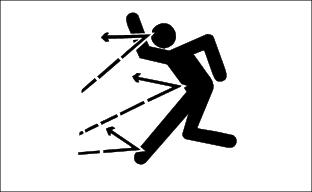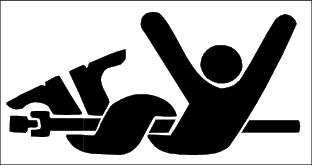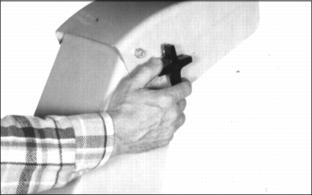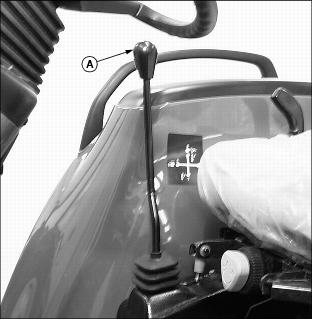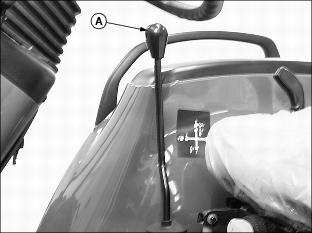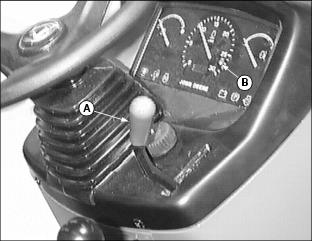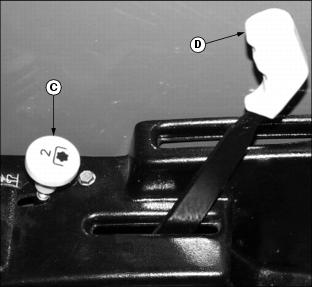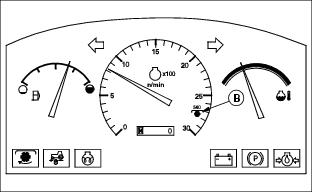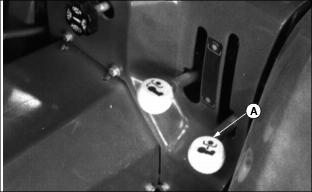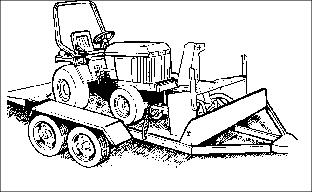for 4200, 4300, 4400 and 790 Compact Utility Tractors 59-Inch
Introduction
Safety Signs
Preparing Vehicle
Installing
Removing
Operating Machine
Operate Snowblower Safely On Slopes
Avoid Injury from Moving Parts
Stay Clear of Rotating Drivelines
Avoid injury from Hitting Obstructions
Raising And Lowering Snowblower
Engaging and Disengaging Snowblower (4000 Series Tractors)
Engaging and Disengaging Snowblower (790 Series Tractors)
Transporting Tractor and Snowblower
Service Machine Safely
Service
Troubleshooting
Storing Attachments
Assembly
Specifications
John Deere Service Literature
Quality Doesn't End When You Invest In A Deere
CopyrightŠ Deere & Company

Operating Machine
Operate Safely
ˇ Check tractor brake action before you operate. Adjust or service brakes as necessary.
ˇ Inspect machine before you operate. Be sure hardware is tight. Repair or replace damaged, badly worn, or missing parts. Be sure guards and shields are in good condition and fastened in place. Make any necessary adjustments before you operate.
ˇ Clear work area of objects that might be thrown Keep people and pets out of the work area. Stop machine if anyone enters the area.
ˇ Be alert for traffic when crossing or working near roadways.
ˇ If you hit an object, stop the machine and inspect it. Make repairs before you operate.Keep machine properly maintained and in good working order. Keep all shields and guards in place.
ˇ DO NOT leave machine unattended when it is running.
ˇ Do not operate equipment when you are tired or ill.
ˇ Only operate during daylight or with good artificial light.
ˇ Look carefully behind tractor before you back up.
ˇ DO NOT let anyone, ESPECIALLY CHILDREN, ride on machine or vehicle.
ˇ DO NOT let children or an untrained person operate machine.
ˇ Do not wear radio or music headphones while operating the machine. Safe operation requires your full attention.
ˇ Be alert for holes, rocks, drop-offs, and hidden hazards. Travel slowly on rough ground.
ˇ Slow down before turning. Avoid sudden turns.
ˇ Keep first-aid kit and fire extinguisher handy. Keep a list of emergency numbers near telephone.
ˇ Don't operate near drop-offs, ditches or embankments.
ˇ DO NOT operate the machine while you are under the influence of drugs.
Operate Snowblower Safely On Slopes
ˇ DO NOT operate on a steep slope where you can't maintain control of the machine. Slopes are strongly related to loss-of-control and tip-over accidents, which can result in severe injury or death. All slopes require extra caution.
ˇ Don't drive where the machine could slip or tip.
ˇ To help prevent loss of steering, braking and stability follow ballast requirements in this manual.
ˇ Keep all movement on a slope slow and gradual. DO NOT make sudden changes in speed or direction.
ˇ Avoid starting or stopping on a slope. If tires lose traction, shut off PTO switch and proceed slowly straight down slope.
ˇ If engine stops as you drive uphill, shut off PTO switch and back down slowly.
Avoid Injury from Moving Parts
ˇ Keep hands, feet and clothing away from snowthrower and discharge chute when auger is turning.
ˇ Stop auger when you are not blowing snow.
ˇ Stop vehicle engine before you unplug, repair, or adjust snowblower.
Stay Clear of Rotating Drivelines
Entanglement in rotating driveline can cause serious injury or death:
ˇ Wear close fitting clothing.
ˇ STOP the engine and be sure PTO driveline is stopped before getting near it.
Avoid injury from Hitting Obstructions
ˇ Raise snowblower when you drive between jobs
ˇ Slow down when you remove snow.
Adjusting Spout
NOTE: When you blow snow from a rough surface, adjust spout to point down so gravel or other surface material is not thrown a long distance.
2. Move spout to desired position.
Raising And Lowering Snowblower
Lower Snowblower
ˇ Push tractor SCV control lever (A) slowly forward to the FLOAT position to lower snowblower.
NOTE: The SCV lever will stay in the float position until you pull back to neutral position.
ˇ Float position allows snowblower to follow contours of the ground.
Raise Snowblower
ˇ Pull tractor SCV control lever rearward to the LIFT position to raise the snowblower.
Turning Chute
NOTE: Chute can be rotated hydraulically 200 degrees.
1. Move SCV lever (A) to the right to turn chute to the right.
2. Move SCV lever to the left to turn chute to the left.
3. Chute should turn 100° to each side.
Engaging and Disengaging Snowblower (4000 Series Tractors)
NOTE: See your tractor operator's manual for location and operation of controls.
2. Move throttle lever (A) to one-fourth engine speed position.
3. Lower snowblower to the ground.
4. Pull up knob (C) to engage tractor mid-PTO.
ˇ Mid-PTO knob is located on right side of tractor operator seat.
NOTE: The PTO lever will activate both the mid and rear PTO shafts when the mid-PTO knob is raised and PTO lever is engaged.
5. Engage tractor PTO lever (D).
ˇ Push PTO lever forward to engage snowblower.
ˇ Pull PTO lever rearward to disengage snowblower.
6. Adjust tractor throttle lever (A) until indicated engine RPM on the instrument panel tachometer is pointing to 2700 rpm or special marker label "540 p" (B).
9. Blow snow at a safe travel speed.
Engaging and Disengaging Snowblower (790 Series Tractors)
NOTE: See your tractor operator's manual for location and operation of controls.
2. Move throttle lever to one-fourth engine speed position.
3. Lower snowblower to ground.
4. Move PTO lever (A) to ON position to ENGAGE snowblower.
5. Move throttle lever to FAST position for best engine and snowblower performance.
8. Blow snow at a safe travel speed.
Stopping Snowblower
NOTE: If engine and snowblower are running, snowblower must stop when you get off operator's seat. If not, have the electrical system checked.
2. Put PTO knob/lever in OFF position.
4. Wait for auger and blower to stop.
5. Lower snowblower to the ground.
Snowblowing Tips
Operate engine at full throttle.
Operate tractor at a safe travel speed.
Slow down when you operate on slopes, before you make a turn, and when you operate close to buildings and trees.
For snowblowing in drifts, drift blade will cut through drifted snow and help break down drifts.
Blow snow down wind if possible.
Put hydraulic control lever forward to float position when you are snowblowing on irregular ground.
Travel slow when blowing wet, heavy snow to prevent plugging.
Clean snowblower after each use.
Look carefully behind tractor before backing up, especially for children.
Raise snowblower when driving between jobs.
Do not clear snow from a steep slope.
Do not operate near edge of ditch, or bank. Keep away from drop-offs, holes, rocks, and roots. Watch for hidden hazards.

